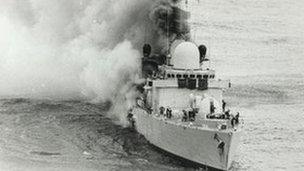HMS Sheffield survivor recalls horror of sinking
- Published
The burnt-out hulk of HMS Sheffield a few days after she was abandoned
A survivor of the sinking of HMS Sheffield has said he believes the time has come to stop trying to lay blame for the tragedy.
Former crew member Chris Purcell, from Portsmouth, will join fellow veterans at a special reunion in the city this weekend to mark the 30th anniversary of the Falklands conflict sinking.
Twenty crew were killed when an Argentine Exocet missile hit the 4,100-tonne destroyer, which had 300 people on board, on 4 May 1982.
Questions have been raised about the ship's readiness for the attack as the missile was spotted by another destroyer nearby.
'Tears shed'
Task force commanders initially dismissed the sighting as "spurious", but within seconds disaster had struck.

A survivor from HMS Sheffield's missile attack in 1982 is led away for treatment
Mr Purcell, a 22-year-old Able Seaman at the time, is today a member of the HMS Sheffield Association.
He said: "The time between spotting the missile and reacting was literally nanoseconds.
"Everything that could have been done in the circumstances was done.
"Thirty years on, there will be lots of stories told and tears shed at the reunion. That's our way of remembering.
"Rather than trying to lay blame for what happened, let's get on with the rest of our lives.
"We will never forget what happened and we will always remember those who lost their lives."
As the Exocet approached, Mr Purcell had just stepped back on deck to wait for the kettle to boil in the galley below.
"I joined the others back on watch and we glanced out to our right, the starboard side, to see a huge fireball coming towards us.
"There was then a thud into the ship's side and another fireball as it hit.
"The upper deck was covered in huge amounts of thick smoke within seconds."
The missile apparently failed to explode, but hit deep into the ship's control room, causing poisonous smoke to billow out on to deck.

Twenty crew were killed and 26 injured
Mr Purcell added: "It had taken out our main fire main. We were pumping water out of the sea and throwing it straight back on to the super structure to try and put out the flames.
"Two ships eventually came alongside to start fighting the fires, but as the water was being sprayed on the super structure, it was bouncing back into people's faces and was boiling."
HMS Sheffield was hit while carrying out a scouting mission off Port Stanley in the South Atlantic.
It was the first British ship to be lost in enemy action since World War II, and the first of four British ships to be sunk by the Argentine air force in the Falklands conflict.
As the fires continued to rage, the burning vessel was abandoned after five hours due to the risk of further explosions.
But the lack of damage below the water line meant HMS Sheffield did not sink immediately.
It continued to burn fiercely for another two days.
A salvage attempt failed and the ship eventually sank while being towed away from the Falklands, almost a week later.
- Published4 May 2012
- Published23 March 2012
- Published3 May 2012
- Published3 May 2012
- Published30 April 2012
- Published2 April 2012